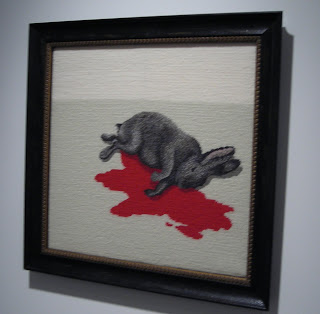"A special exhibition designed to accelerate the rate at which fine artists express the ideas and emotions to influence other artistic mediums and ultimately social and political viewpoints. "Partisan" is curated and juried by prominent artists from a range of fields who are known for their social activism."
So here are two images from "Partisan," the bottom image is by Renee Cox and is called Liberation of Aunt Jemima and Uncle Ben (1998). The top image is Guma Guar's You Are All Faggots from 2006 (sorry it only imports horizontally).
I'm not sure who the jurors were as I don't think they were listed, but the advisory panel included the actor Martin Sheen, musician Jeff Tweedy, Lin Brehmer (possibly a Chicago-based morning radio host), and Father Andrew Greeley (i think a progressive catholic priest in oak park). Martin Sheen gets out there and protests and gets arrested. He has credibility in this sense. This exhibition seems to be an honest attempt to represent this kind of work. Yet, I was dumbfounded at its exhibition within Artropolis. What purpose can it serve here, next to the food court? If you were a visitor to the art fair would you notice these works or walk right past them?
It is interesting that this exhibition is included; I'm not sure if its inclusion is a good thing. On one hand, if Artropolis is presenting a selection of contemporary and modern work from around the world, shouldn't this kind of work have some visibility also? Hasn't the criticism within social activist circles been that this kind of work doesn't get play within mainstream venues? So then, isn't it good to get the word out to a mass audience? And, while most of this work is overly didactic, it is critical of, and sheds light upon certain policies, attitudes, and modes of behavior that permeate the way that we live. It is confrontational in a sense--messing around with popes can still be pretty scandalous--and has the possibility of offending someone, if they happen to accidentally come face-to-face with it, so it's not like these works are safe attempts at social activist art. So, why am i bothered by their inclusion?
First of all, I think that the most interesting "social activist" work being created is not object-based, it is experience, project, or community-based (here I simplify). The work on display is easily digestible; images that are easily marketable. Most importantly they are "social activist" work in a commercially-viable form. Indeed, the label for Guar's work refers the viewer to a booth in NEXT where I assume that it may be purchased. In contrast, the most interesting work of this kind that I know of is complex, not available in an easily understood image. The work on display at Art Chicago seems, well, a bit dated to me in its approach.
Last year at Artropolis there were a host of events that included artists, designers, and curators talking about social activism and art. Yet, for people interested in that kind of work it seemed odd in such a highly commercial entity. I remember Mary Patten, a School of the Art Institute of Chicago professor, and member of ACT-UP, whose work deals, in part, with prisons and prisoners rights, speaking on a panel at Artropolis whose theme I forget now. She mentioned that she felt so weird being on that panel and in that commercial space because her work generally operated away from those interests. And, indeed, for me as an audience member I felt out of place too because the reasons for making social activist art are supposed to be more detached from the buy-sell mentality of commercial art. Yet, I think that this is probably a simplified view of how the art world works. Artists need to be able to eat, pay rent, buy supplies, travel--even those that create work that is engaged with a social agenda. How do they do this if they don't have family money, grant money, a teaching gig/s or some other source of income? Art fairs are incredible opportunities for exposure for artists who must constantly market themselves, and i suppose, they are a great way to network too. Can they serve a purpose for artists interested in social activism?
Art fairs are straight-up commercial venues. I don't know about other fairs, but Art Chicago and NEXT seemed to at least include some work that may be more esoteric or less-commercially friendly, and seemed at least conscious of including more non-traditional art making practices. But maybe Art Fairs really aren't a proper venue for this kind of work. I think perhaps not, if the ultimate goal is to sell work. It just seems like a misplaced gesture. Perhaps a separate exhibition or project away from the Merchandise Mart would be a better solution? I also think that tapping in to the community here in Chicago who practices this kind of art would be helpful too. But I think that a social and political agenda gets lost in the vast space of the Mart with "16,000 pieces of artwork displayed by 780 exhibitors from 242 cities and 28 countries at five concurrent shows under one roof" (from Christopher G. Kennedy's welcome in the Artropolis brochure). It is an innappropriate venue for work that strives for something beyond commercial viability.












